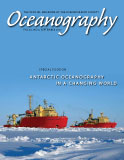Article Abstract
Little is known of New Guinea’s deep benthic communities. In fall 2010, the Muséum national d’Histoire naturelle, Institut de Recherche pour le Développement, and University of Papua New Guinea spearheaded an international three-leg cruise, BioPapua, aimed at exploring the deep waters of eastern Papua New Guinea and its satellite islands. Special attention was given to faunal assemblages associated with sunken wood and decomposing vegetation as well as seamount summits and slopes. In this article, we review the information available on the deep ecosystems of Papua New Guinea and summarize preliminary results of the BioPapua cruise.

